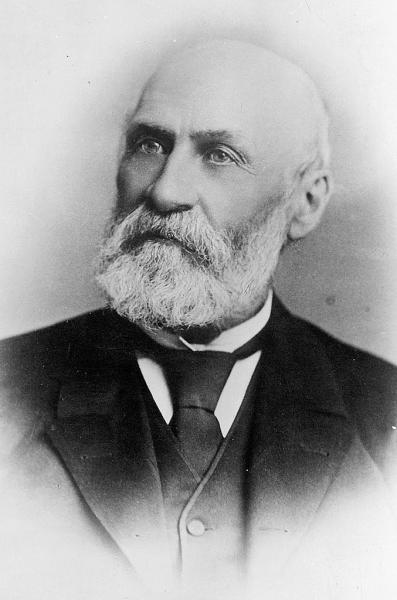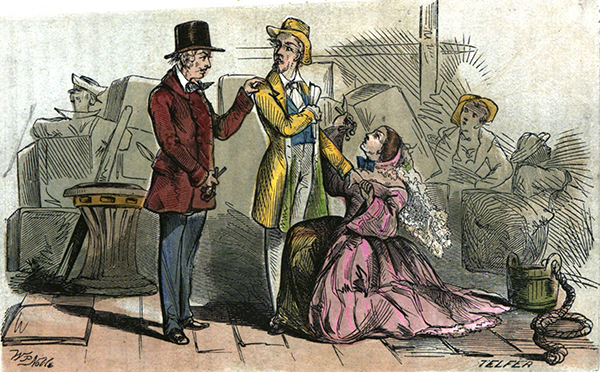By Christopher Phillips, University of Cincinnati
Biographical information:
- Date of birth: July 21, 1818
- Place of birth: Hardwick, Massachusetts
- Claim to fame: Leader of the New England Emigrant Aid Company; first governor of Kansas, 1861-1863; first governor of any state to be impeached; husband of Sara Robinson
- Political affiliations: Free-State Party, Republican Party
- Date of death: August 17, 1894
- Place of death: Lawrence, Kansas
- Final resting place: Oak Hill Cemetery, Lawrence, Kansas
Charles Robinson, the first governor of the state of Kansas, was born on July 21, 1818, in Hardwick, Massachusetts. Raised by abolitionist parents, he attended Amherst College and then studied and practiced medicine. When his health declined, he left his practice and became physician for a group of about 50 emigrants from Boston who had formed a joint stock company and were traveling to California during the gold rush. There, Robinson mined and operated an eating house for emigrants.
In California, Robinson began a newspaper, the Miner’s and Settler’s Grant, and was elected president of a local squatters’ association, through which he involved himself in land disputes with speculators. On one occasion, after he was attacked and shot in the chest, Robinson managed to kill his assailant with an iron bar and was charged with murder. While imprisoned aboard a ship in 1850, his constituents elected him to the new state legislature. (He was exonerated of the murder charge.) There he consistently advocated positions opposed to the extension of slavery to California.
Proslavery fraud in Kansas’s territorial election propelled Robinson to advocate Free-State settlers’ armed resistance.
Returning to Massachusetts in 1854, Robinson was appointed a Kansas agent of the New England Emigrant Aid Company and journeyed to newly-opened Kansas Territory to gather information helpful to settlers. After publishing a pamphlet for prospective settlers, he led the first two groups of migrants to the present site of Lawrence and assisted with its construction. Proslavery fraud in Kansas’s territorial election propelled Robinson to advocate Free-State settlers’ armed resistance, and in 1855 he commanded the town’s defense against Missouri invaders during the Wakarusa War.
Robinson’s leadership helped secure a majority of Free-State candidates in the territorial legislature, virtually ending the possibility of Kansas becoming a slave state.
In 1856, Robinson assisted in the organization of the Free-State Party at Big Springs, and he led the party’s radical wing at the constitutional conventions at Topeka. He was chosen governor of the territory’s rump Free-State government, formed in protest of the widespread fraud that had helped to elect largely proslavery candidates to the territorial legislature at Lecompton, and a grand jury indicted them, along with other Free-State leaders, for treason. While traveling to the East to gain aid for the Kansas Free-Staters, Missourians arrested and returned Robinson to Kansas, where for four months he was imprisoned at the proslavery bastion of Lecompton. By 1858, having denounced both violence and fraudulent voting (including his opposition to both the Lecompton and Leavenworth constitutions), Robinson’s leadership helped secure a majority of Free-State candidates in the territorial legislature, virtually ending the possibility of Kansas becoming a slave state.
Robinson’s longtime efforts were rewarded in the summer of 1859 when the Wyandotte Constitution not only prohibited slavery, but extended citizenship rights (with the exception of voting) to African Americans. In October, Kansas voters approved the constitution nearly 2 to 1, and Robinson was nominated for governor as a Republican. In 1861, when Kansas became a state, he served one term as the new state’s first governor. Robinson’s governorship was marred by scandal related to a bond issue. The state’s House of Representatives impeached him, and he was tried for corruption. Although cleared, he was unable to escape perceptions of impropriety and was further unable to build a favorable relationship with the Lincoln administration. Robinson left office in 1863.
In his later years, Robinson espoused reformist causes, such as blacks’ and women’s suffrage, currency reform, and public education. He ran unsuccessfully for U.S. congressman and governor of Kansas, and from 1887 to 1889, he served as president of Haskell Institute in Lawrence, an off-reservation boarding school with an institutional goal of “civilizing” Native Americans (that is today Haskell Indian Nations University). Robinson died at his home outside Lawrence on August 17, 1894.
Suggested Reading:
Blackmar, Frank W. The Life of Charles Robinson: The First Governor of Kansas. Topeka: Crane & Co., 1902.
Castel, Albert E. A Frontier State at War: Kansas 1861-1865. Ithaca: Cornell University Press, 1958.
Etcheson, Nicole. Bleeding Kansas: Contested Liberty in the Civil War Era. Lawrence: University Press of Kansas, 2004.
Cite This Page:
Phillips, Christopher. "Robinson, Charles" Civil War on the Western Border: The Missouri-Kansas Conflict, 1854-1865. The Kansas City Public Library. Accessed Saturday, April 27, 2024 - 08:10 at https://civilwaronthewesternborder.org/encyclopedia/robinson-charles



